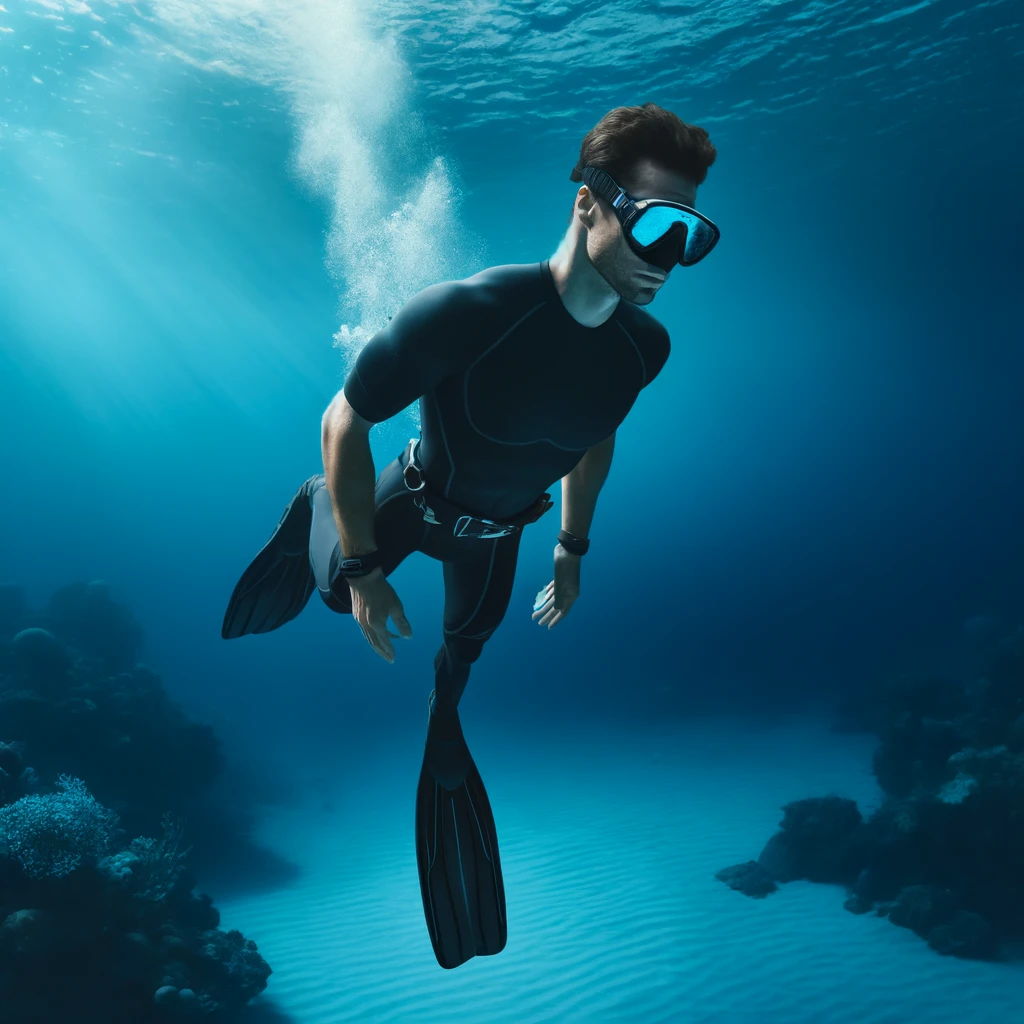Apnea, also known as free diving or free diving, is a very old practice, but its formalization as sport occurred more recently. Historically, apnea was used by ancient people to collect food, practice fishing and even in military activities.
The sport apnea as it is known today began to take shape at the beginning of the 20th century, but it was in the 1940s that it began to be more recognized, especially with figures such as Raimondo Bucher, an Italian diver who performed a free dive to a depth of 30 meters in 1949. This event is often considered a milestone for competitive freediving.
In the following years, the sport gained popularity with more divers participating and organized competitions being held. AIDA (International Association for Development of Apnea) was founded in 1992 and is one of the organizations that helped master rules and promote apnea competitions around the world.
Browse Content

Technology Applied in Sport
Technology and science applied to the sport have also evolved significantly, allowing divers to reach impressive depths and remain submerged for increasingly longer periods of time.
Understanding of human limits and safety techniques has improved, making the sport more accessible and safe for practitioners.
Technology applied in the sport of apnea has played a crucial role in increasing athletes' performance and ensuring safety during competitions and training. I will highlight some of the main technologies and innovations used
Dive Watches and Computers, These devices are essential for breath-hold divers. They help monitor dive time, depth reached, water temperature, and even heart rate.
Specialized Neoprene WetsuitsApnea wetsuits are designed to provide excellent thermal insulation while maximizing freedom of movement. They also help with buoyancy, which is critical to diving efficiency.
The 5 Apnea Modalities
- Static Apnea (STA)
- The athlete tries to stay submerged for as long as possible without moving, usually in a swimming pool. Performance is measured by breath retention time.
- Dynamic Apnea with Fins (DYN)
- This sport involves swimming as far as possible in a pool using fins. It is proof of efficiency in underwater movement and lung capacity.
- Dynamic Finless Apnea (DNF)
- Similar to dynamic apnea with fins, but performed without the aid of fins. This discipline requires more technique and physical strength, as the athlete depends exclusively on body movement to move through the water.
- Constant Weight with Fins (CWT)
- The competitor uses fins and descends along a rope to the announced depth, without the help of pullable weights or underwater vehicles. The return must also be done without external assistance, except by pushing the fins.
- Constant Weight Without Fins (CNF)
- Similar to constant weight with fins, but the diver does not use fins. It is considered one of the purest and most challenging forms of apnea because it requires exceptional buoyancy control and swimming technique.
- Free Immersion (END)
- The athlete only uses the depth rope to move up and down, without the aid of fins or other equipment. This modality focuses on the ability to control the rope and the efficiency in conserving oxygen.
Safety equipment
Safety and Rescue Equipment Technologies such as signaling buoys, emergency oxygen masks and underwater communication equipment are essential to guarantee the safety of divers during intense competitions and practices.
These technologies not only allow divers to safely reach and exceed their limits, but also contribute to a better understanding of human physiology under extreme conditions of pressure and limited oxygen.
Physical and Technical Conditioning
Inadequate preparation is a common cause of problems during breath holding in sports. Athletes who do not have good physical or technical conditioning may face difficulties managing their oxygen and carbon dioxide levels, which can lead to dangerous situations such as hypoxia (low concentration of oxygen in the blood) and hypercapnia (accumulation of carbon dioxide). carbon in the blood.
Especially at competitive levels, it requires careful supervision and specific training. The absence of a coach or experienced dive buddy can significantly increase the risk of accidents. Training should include breathing techniques, impulse control and safety procedures.
Diagnosis and Monitoring in Sports Apnea
For athletes who practice breath-holding in sports, it is crucial to establish diagnostic and monitoring methods to prevent complications and optimize performance. Let's look at some important approaches to diagnosis and monitoring.
Regular Medical Assessments** Athletes who practice apnea must undergo regular medical assessments to ensure there are no underlying health conditions that could increase the risks associated with the sport. These evaluations may include cardiovascular exams, pulmonary function tests, and neurological evaluations.
Monitoring Heart Rate and Oxygen Saturation During training and competition, continuous monitoring of heart rate and oxygen saturation levels can help ensure athletes remain within safe limits. Portable monitoring devices like pulse oximeters are valuable tools
Training with Qualified Professionals.
Training with Qualified Professionals Working with qualified instructors and trainers-qualified-A-Apnea can help Apnea can help These professionals can also help identify early warning signs of problems during apnea and adjust training to improve safety and performance.
Training Diaries and Regular Feedback Keeping a detailed record of training, including duration of apnea, sensations and any symptoms experienced, can be a useful diagnostic tool. Regular feedback from coaches, along with analysis of these journals, can help identify patterns or issues that need attention.
Regulations and Security
- Regulations: Competitions are often regulated by organizations such as AIDA (International Association for the Development of Apnea) and CMAS (World Confederation of Underwater Activities), which establish the rules and ensure safe practices.
- Security: Given the potentially dangerous nature of the sport, safety is paramount. This includes the presence of a trained security team, well-defined emergency procedures, and on-site medical supervision.
The sport of freediving is both a test of physical and mental ability, challenging athletes to surpass their limits while maintaining strict control over their bodies and minds in an underwater environment.
Athletes must wear appropriate equipment, which may include neoprene suits to aid buoyancy and body temperature, quality diving masks and, in some cases, weights for freediving.Beneficial to the Sport.
How frequent is apnea practice in Brazil?
Freediving is a growing sport globally, and Brazil, with its vast coastline and interest in water sports, is likely to see a variety of freediving activities ranging from recreational to competitive levels.
For more accurate data, it would be beneficial to consult local freediving clubs or national sports associations in Brazil.
Impact of Apnea on Health and Quality
Apnea, especially sleep apnea, significantly impacts health and quality of life. Sleep breathing disorders, such as obstructive sleep apnea, result in fragmented sleep and inadequate blood oxygenation, leading to chronic fatigue, daytime drowsiness and decreased cognitive ability.
This increases the risk of accidents and mental health problems such as depression. Furthermore, untreated apnea is associated with serious conditions including hypertension, heart disease and type 2 diabetes, highlighting the need for early diagnosis and effective treatment to improve overall health and well-being.
Effective sleep apnea treatment can transform the lives of those who suffer from this condition. Through interventions such as the use of CPAP (continuous positive airway pressure), lifestyle changes such as weight loss and smoking cessation, and, in some cases, surgical interventions, patients can experience a significant improvement in the quality of their health. sleep.
These changes lead to a reduction in symptoms of fatigue and irritability, improved concentration and mood, in addition to reducing the risk of developing more serious comorbidities. Therefore, an accurate diagnosis followed by appropriate treatment is crucial to regaining quality of life and ensuring long-term health.
Conclusion
Recognizing and treating apnea is fundamental to overall health and well-being. This condition, characterized by repeated pauses in breathing during sleep, not only compromises sleep quality, but also increases the risk of numerous health complications, such as cardiovascular and metabolic diseases.
Furthermore, apnea significantly impacts quality of life, causing daytime fatigue, concentration and mood problems, which can affect personal and professional relationships. Fortunately, with proper diagnosis and a variety of treatment options available, individuals with sleep apnea can effectively manage their symptoms and significantly improve their health.
Therefore, it is crucial that those who show signs of apnea seek medical evaluation to begin the path towards a healthier and more revitalized life.
Therefore, we encourage anyone experiencing persistent symptoms related to sleep quality not to ignore these issues. Starting a conversation with a healthcare professional about your symptoms can be a crucial first step toward an accurate diagnosis and effective treatment plan.
Timely interventions not only alleviate daily symptoms but also prevent long-term complications, substantially improving longevity and quality of life.







Leave a Comment